During our road trip through Chile and Argentina we crossed the border between Chile and Argentina twice. From Chile to Argentina we crossed the little used Sico Pass and from Argentina to Chile we crossed the busy Paso de Jama. Since at both passes the landscape captivates with innumerable gentle and rough hill ranges, we planned one route for the outward journey and one for the return journey. How the border crossing between Chile and Argentina exactly runs you will learn in this article.
Entering Argentina through the Sico Pass
The journey from San Pedro de Atacama to the Sico Pass takes about 4 hours. On the way there are several sights like the Laguna Miniques. The route is really worth seeing, so you can enjoy the view while continuously driving up the mountains by car.
Partly we could only drive in first gear to overcome the altitude difference. In San Pedro de Atacama you start at about 2500 meters altitude, at the Sico Pass you are meanwhile at almost 4500 meters above zero.

Shortly before the border you first pass a post of the Chilean gendarmerie. Here you can drive by slowly and actually don’t have to stop. We did – such a stop sign is not simply driven over – but the border policeman simply sent us on. After that, we continued for a few more kilometers.
At the national border the asphalted road ends abruptly, the actual border post follows a little later. Here on the left side is the border building where the formalities are settled. We were lucky to be the only people there, so that we didn´t had to wait. But that did not mean that it was quick. We had to communicate with hands and feet, because the employees at the Sico Pass do not speak English.
After some time we had understood that there are a total of 4 counters and we have to wait at counter No. 1. We also got a piece of paper on which we had to fill in our names and the license plate number of the rental car. It took just under 20 minutes until the employee for counter 1 finally showed up and we were off. You should have the following things handy at the counter:
- Passport
- the piece of paper you received when entering Chile (e.g. at the airport)
- all papers of the car (usually you get them from the car rental company)
The 4 Counters at the Border Crossing
To cross the border, you must go through the following four counters in the correct order.
Counter 1
First you have to leave the country (in our case Chile). So you get an exit stamp in your passport, a stamp on the previously filled out slip and get everything back. Here you also have to hand in the piece of paper you received when entering Chile (e.g. at the airport). Then it goes to the next counter.
Counter 2
Immediately after the departure the entry takes place. So follows the next stamp in the passport and on the slip. After that you get everything back and go to counter 3. 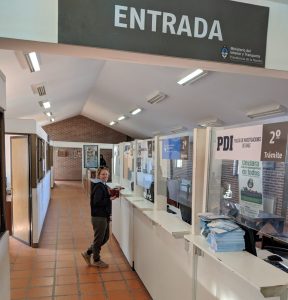
Counter 3
Now it is about the car. Here you have to present the documents prepared by the rental car company. The documents as well as the well-known slip are stamped, signed and one goes to the fourth and last counter.
Counter 4
At the fourth and last counter it is still about the customs matters. For the trip from Chile to Argentina there was nothing to consider. The rules for entering Chile can be found below
Four counters, one hour and a lot of stamps later we could finally leave the border building. With our car we went to the barrier and there the filled out and fully stamped piece of paper was used again. You have to give it to the barrier and if everything is ok, the barrier is opened and you are allowed to enter Argentina.
General info about the Sico Pass
- At the Sico Pass there is only the border building
- The employees speak only spanish
- The roads around this border crossing in Argentina are pure gravel roads
- There are:
- no gas station
- no cash machine
- no store to buy anything
Entering Chile via Paso de Jama
After almost 1.5 wonderful and exciting weeks in Argentina we went back to Chile. In order to see more of the landscape, we chose for the return, not as for the entry the Sico Pass, but the Paso de Jama. This pass is used much more frequently than the Sico Pass and is therefore also passed by many trucks and coaches.
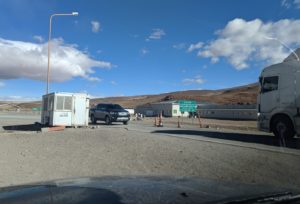
Since we arrived at Paso de Jama in the late afternoon after a drive of several hours, we decided to spend the night in the hotel of the local YPF gas station. Our expectations were very high, as YPF gas stations have always been very fancy so far, with clean and modern restrooms. Unfortunately, we were disappointed.
The triple room (all double rooms were apparently occupied) was rather standard. Very old furniture and it was very sparsely furnished. In addition, the cold wind pulled through the unsealed windows and also the water from the shower was unfortunately only cold … and all this for 1200 ARS (about 24 Euro) per night.
But since there was no other place to stay nearby, we didn’t have much choice. For it we could invest our last Argentine peso in candy and again full tank before it went on the next day in the direction of Chile.
Truck Traffic Jam at the Border
The next morning we already saw the picture at the border, which we had read in many reports before. Already in the early morning there was a whole row of trucks at the border. Since we were unsure whether trucks and cars are cleared together, we drove past the trucks after a few minutes and have placed us in front of the small border house at the closed lane.
After a few minutes, a truck driver approached us and told us that the border would not open until 12 noon today. While we were already preparing for the hour-long wait, a border policeman suddenly came to us, asked for the number of people, pressed the familiar piece of paper for stamping into our hands and waved us through. So we drove a few meters further and parked in front of the border building on the left side. Here everything went quite fast this time. There were again the familiar four counters (see above).
- Counter 1: Exit
- Counter 2: Entry
- Counter 3: Checking the car papers
- Counter 4: customs
Food Control
At the customs they check if you have fresh food with you when you enter Chile. These are not allowed to be brought into Chile. This was not checked when entering Argentina. Since we had declared our food truthfully on the form, the border official even came out with us to the vehicle and roughly checked what we had in the car. We had to hand over our fresh fruits and vegetables (we ate the bananas quickly on the spot).
The little bit of butter and the two slices of cheese were allowed to enter Chile with us. The procedure at the four counters at Paso de Jama was very fast compared to the Sico Pass. In total, the process took about 20 minutes, because we were again the first in line. Also, the employees are more attuned to tourists and speak Spanish slowly or partly a little English. From the border we went back to San Pedro de Atacama within about 3 hours.
General Info about the Paso de Jama
- The employees speak a few words of English
- Immediately before the border there is a gas station with a small store (there are sweets, drinks, rolls, small snacks)
- There is a hotel in the gas station
- There is no cash machine
Taking Food across the Border
When entering Chile, there are strict regulations concerning the taking of food. This is valid for the entry by plane as well as for the entry by rental car. Argentina has much less strict regulations. What kind of food you are allowed to bring into Chile you can read in the next section.
Import of Food to Chile
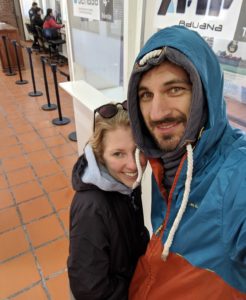 When importing food to Chile, the police is very strict..There are sniffing dogs running around everywhere at the airport, looking for food you brought with you. If a dog finds something in your bag, you get a red tape on your backpack and the border official knows immediately that he has to look more closely.
When importing food to Chile, the police is very strict..There are sniffing dogs running around everywhere at the airport, looking for food you brought with you. If a dog finds something in your bag, you get a red tape on your backpack and the border official knows immediately that he has to look more closely.
Control at the Airport
At the airport you have to mark on a piece of paper if you have food with you. In addition, the sniffer dogs are running around and at the customs check you are checked accordingly. However, the officials search the backpacks rather quickly and vaguely. They rather ask what you have with you. Some things in my backpack – which we forgot to declare – they simply overlooked.
Control at the Entry by Rental Car
When entering the country by rental car, the whole thing looks similar. You have to write down on a piece of paper what kind of food you have with you and then the border official asks again. We had given everything properly and the official therefore came out with us to the car and searched it.
But again, rather half-heartedly. The whole thing lasted only a few minutes, in which we had eaten our bananas and he confiscated our onions and the rest of the vegetables. But we have also heard of other travelers who had their whole car taken apart.
Import of Food to Argentina
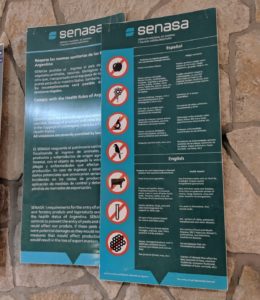 We were not asked for food when we entered Argentina by rental car and our car was not checked. But officially there are similar strict guidelines for the import of food. You can read them here on the official website of the Argentine Embassy: official PDF of the Argentina Embassy.
We were not asked for food when we entered Argentina by rental car and our car was not checked. But officially there are similar strict guidelines for the import of food. You can read them here on the official website of the Argentine Embassy: official PDF of the Argentina Embassy.
After that you are not allowed to import:
- Seeds, flowers, soil, bulbs
- Meat and meat products
- Fruits and vegetables
Do you have any questions or your own experiences about the border crossing? Then write us a comment.


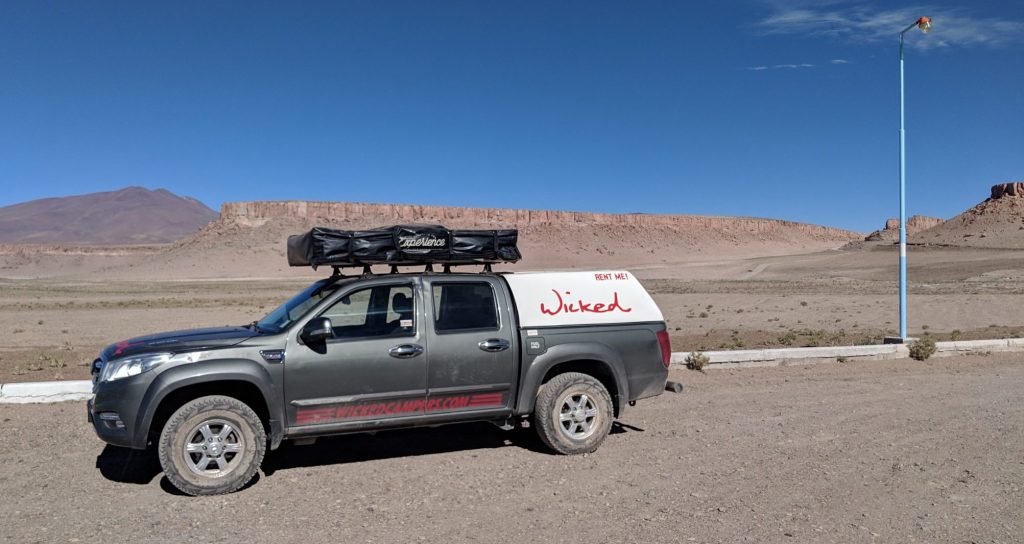



Thanks for the info regarding food transport between the 2 countries. Were markets easy to find along the route between the countries? We will be on the road for 3 weeks.
Hi Audra,
when you mean public markets, then no. When you mean sth like supermarktes. yes in the towns on the route there were. But not really big ones. The best selection you will have in salta, which is a huge city.
Best wishes and great trip,
Andreas
Thank you for the info very precise !
Did you have any international driving license given by your rental car office ?
We would like to cross the borders in Pantagonia but our rental car office does not give any permission to cross the border.
Thank you for your advice
Hi Charly,
I think we had an international driving license with us, but we didnt need it. Our german license was sufficient.
Best wishes
Andreas
I’m a US resident. I bought a van in Santiago to travel South America over the next few years. I’m now in Arica Chile and have been turned back at both the Peru and the Bolivia boarders. I’m at a loss at what to do next. And help would be appreciated
Hi Kim,
sorry but we cannot help you. Maybe you contact the us embassy for help.
Good Luck!
Best wishes,
Andreas
Hey. Good information.
I will be travelling from SAN Pedro de Atacama to Jama in October by rental motorcycle . My main worry is fuel. Is the fuel station at the border open? I have read it’s closed. There’s no fuel guaranteed for 250km after.
I also learned that to carry extra fuel is forbidden.
Any tips?
Thanks, Brian
Hi Brian,
I am sorry, but I think we cant help you with that information. You could ask your rental company.
Good Luck anyway!
Best wishes,
Andreas
Hi, just found your travel blog. Hope you still read the comments. As we see on several sites we need some special papers to cross the border from Chile to Argentina and back. In your blog I see you only need papers issued by the rental car company, a valid passport and the document we receive when entering Chile. No Visa of any kind no special papers…?
Many thanks in advance
Erik
Hi Erik,
weather you need a Visa or not depends on the country you are from. So please check with your own embassy.
Best wishes,
Andreas
Hi Andreas, thanks for the reply!! We are from the Netherlands so I I will check. But am I correct if there is no special paper you need from the rental company?
Kind regards,
Erik
Hi Erik,
yes you need one. You need to inform the rental company in advance. They will give you this paper. Check out wicked camper as mentioned on our blog.
Best wishes
Andreas
Hi Erik,
Yes, 72 hours before pick up you have to send an email to the rental car company with copy passport and driver license and ask them for the Border Crossing Papers. Also the car must have SOAPEX insurance. So arrange that before entering Chili! 😉
Thanks very much for the info!! Really appreciated.